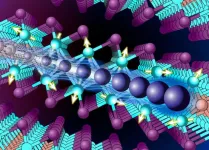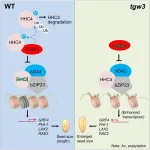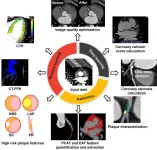(Press-News.org) Researchers have discovered the oldest black hole ever observed, dating from the dawn of the universe, and found that it is ‘eating’ its host galaxy to death.
The international team, led by the University of Cambridge, used the NASA/ESA/CSA James Webb Space Telescope (JWST) to detect the black hole, which dates from 400 million years after the big bang, more than 13 billion years ago. The results, which lead author Professor Roberto Maiolino says are “a giant leap forward”, are reported in the journal Nature.
That this surprisingly massive black hole – a few million times the mass of our Sun – even exists so early in the universe challenges our assumptions about how black holes form and grow. Astronomers believe that the supermassive black holes found at the centre of galaxies like the Milky Way grew to their current size over billions of years. But the size of this newly-discovered black hole suggests that they might form in other ways: they might be ‘born big’ or they can eat matter at a rate that’s five times higher than had been thought possible.
According to standard models, supermassive black holes form from the remnants of dead stars, which collapse and may form a black hole about a hundred times the mass of the Sun. If it grew in an expected way, this newly-detected black hole would take about a billion years to grow to its observed size. However, the universe was not yet a billion years old when this black hole was detected.
“It’s very early in the universe to see a black hole this massive, so we’ve got to consider other ways they might form,” said Maiolino, from Cambridge’s Cavendish Laboratory and Kavli Institute of Cosmology. “Very early galaxies were extremely gas-rich, so they would have been like a buffet for black holes.”
Like all black holes, this young black hole is devouring material from its host galaxy to fuel its growth. Yet, this ancient black hole is found to gobble matter much more vigorously than its siblings at later epochs.
The young host galaxy, called GN-z11, glows from such an energetic black hole at its centre. Black holes cannot be directly observed, but instead they are detected by the tell-tale glow of a swirling accretion disc, which forms near the edges of a black hole. The gas in the accretion disc becomes extremely hot and starts to glow and radiate energy in the ultraviolet range. This strong glow is how astronomers are able to detect black holes.
GN-z11 is a compact galaxy, about one hundred times smaller than the Milky Way, but the black hole is likely harming its development. When black holes consume too much gas, it pushes the gas away like an ultra-fast wind. This ‘wind’ could stop the process of star formation, slowly killing the galaxy, but it will also kill the black hole itself, as it would also cut off the black hole’s source of ‘food’.
Maiolino says that the gigantic leap forward provided by JWST makes this the most exciting time in his career. “It’s a new era: the giant leap in sensitivity, especially in the infrared, is like upgrading from Galileo’s telescope to a modern telescope overnight,” he said. “Before Webb came online, I thought maybe the universe isn’t so interesting when you go beyond what we could see with the Hubble Space Telescope. But that hasn’t been the case at all: the universe has been quite generous in what it’s showing us, and this is just the beginning.”
Maiolino says that the sensitivity of JWST means that even older black holes may be found in the coming months and years. Maiolino and his team are hoping to use future observations from JWST to try to find smaller ‘seeds’ of black holes, which may help them untangle the different ways that black holes might form: whether they start out large or they grow fast.
The research was supported in part by the European Research Council, the Royal Society, and the Science and Technology Facilities Council (STFC), part of UK Research and Innovation (UKRI).
END
Astronomers detect oldest black hole ever observed
2024-01-17
ELSE PRESS RELEASES FROM THIS DATE:
Columbia chemists create the first 2D heavy fermion
2024-01-17
Researchers at Columbia University have successfully synthesized the first 2D heavy fermion material. They introduce the new material, a layered intermetallic crystal composed of cerium, silicon, and iodine (CeSiI), in a research article published today in Nature.
Heavy fermion compounds are a class of materials with electrons that are up to 1000x heavier than usual. In these materials, electrons get tangled up with magnetic spins that slow them down and increase their effective mass. Such interactions are ...
Therapy versus medication: comparing treatments for depression in heart disease
2024-01-17
New research by investigators from the Department of Psychiatry and Behavioral Neurosciences at Cedars-Sinai shows that behavioral activation therapy is as effective as antidepressant medications in treating symptoms of depression in patients with heart failure.
Heart failure affects nearly 6 million adults in the United States, and approximately 50% of heart failure patients experience symptoms of depression along with their condition. Past studies show patients with heart failure and depression have lower cardiac function, more emergency department ...
Active membranes: The future of fresh water is bright
2024-01-17
The growth of Los Angeles as a startup hub is highlighted by a robust and diverse entrepreneurial ecosystem within UCLA. The Magnify Incubator at CNSI is no exception to showcasing the range of early-stage businesses.
One such company within the Magnify incubator, Active Membranes, is innovating the future of fresh water through membrane desalination. As freshwater is becoming increasingly scarce around the globe, resources such as seawater and industrial wastewater are costly to procure and operate. The company’s patented technology is electrically conducting ...
What’s stopping US climate policies from working effectively
2024-01-17
In an effort to reduce greenhouse gas emissions and curb global warming, the U.S. has enacted several ambitious federal laws, such as the Inflation Reduction Act (IRA) passed in 2022 and the Infrastructure Investment and Jobs Act (IIJA) of 2021.
These provide significant investments in clean energy projects and encourage technological innovations. Some analyses suggest they could reduce greenhouse gas emissions by more than 40% below 2005 levels by 2030.
However, in a paper published Jan. 16 in the journal Nature Climate Change, researchers at the University ...
Chromatin modifier-centered pathway points to higher crop yield
2024-01-17
Chromatin is the complex of DNA and proteins that makes up the genetic material in the nucleus of eukaryotic cells. A chromatin modifier is a protein or complex of proteins that chemically modifies the structure of chromatin. Chromatin modifiers play a crucial role in regulating the expression of genes, which are segments of DNA strands, as well as in other chromatin-related processes. These modifiers mainly work by adding or subtracting chemical groups to histones, a type of protein within the chromatin, or to the DNA itself.
In the scientific effort to manipulate the expression of plant genes, such as for grain size or drought-resistance, etc., understanding the influence ...
U.S. voters’ climate change opinions swing elections
2024-01-17
When voters cast their ballots in the 2016 and 2020 presidential elections, many were driven by their concern for climate change, according to new research out of CU Boulder’s Center for Environmental Futures (C-SEF). The new report determined that views on climate change played a significant role in whom people voted for, concluding that the climate issue very likely cost Republicans the 2020 election, all else equal.
“This is obviously information that politicians and advocates across the political spectrum will want to know, heading into the 2024 election cycle,” said Matthew Burgess, CIRES Fellow and C-SEF director. “How ...
Artificial intelligence helps coronary CT angiography and accelerates the development of precision medicine
2024-01-17
This review was jointly published by Prof. Long-Jiang Zhang (Department of Radiology, Jinling Hospital, Affiliated Hospital of Medical School, Nanjing University) and Prof. Christian Tesche (Division of Cardiovascular Imaging, Department of Radiology and Radiological Science, Medical University of South Carolina and Department of Cardiology, Munich University Clinic, Ludwig-Maximilian-University).
With the continuous progress of science and technology, artificial intelligence (AI) has become an important driving force for a new round of scientific and technological revolution and industrial change. It aims to mimic human consciousness and thought processes, continuously ...
New research finds half-cardio, half-strength training reduces cardiovascular disease risks
2024-01-17
AMES, Iowa — Approximately one in three deaths in the U.S. is caused by cardiovascular disease, according to the U.S. Centers for Disease Control and Prevention. A robust body of evidence shows aerobic exercise can reduce risks, especially for people who are overweight or obese. But few studies have compared results with resistance exercise — also known as strength or weight training — or with workout regimens that are half aerobic and half resistance. Researchers at Iowa State University led one of the longest and largest supervised exercise trials to ...
ECOG-ACRIN Cancer Research Group melanoma research team led by Michael Atkins, MD, receives the 2023 Paper of the Year distinction from the Journal of Clinical Oncology
2024-01-17
A team of melanoma researchers with the ECOG-ACRIN Cancer Research Group (ECOG-ACRIN) is honored with the 2023 Paper of the Year distinction by the Journal of Clinical Oncology. The recognition is for the results of the DREAMseq randomized phase 3 clinical trial. DREAMseq (EA6134) showed an optimal treatment sequence for combination therapy in patients with advanced melanoma with a BRAFV600 tumor gene mutation. The treatment sequence beginning with immunotherapy (nivolumab and ipilimumab), followed by targeted therapy (dabrafenib and trametinib) if there was disease progression, resulted ...
The American Journal of Clinical Nutrition launches new article series to educate physicians and other health care professionals on nutrition
2024-01-17
Rockville, MD (January 16, 2024) – To educate physicians and other health care professionals on the fundamentals of nutrition, The American Journal of Clinical Nutrition has launched a new article series titled Nutrition for the Clinician. The effort supports the White House National Strategy on Hunger, Nutrition, and Health and its directives to expand nutrition knowledge of health care providers, an effort long supported by the American Society for Nutrition. Nancy Krebs, MD, MS, Professor of Pediatrics, University of Colorado ...




